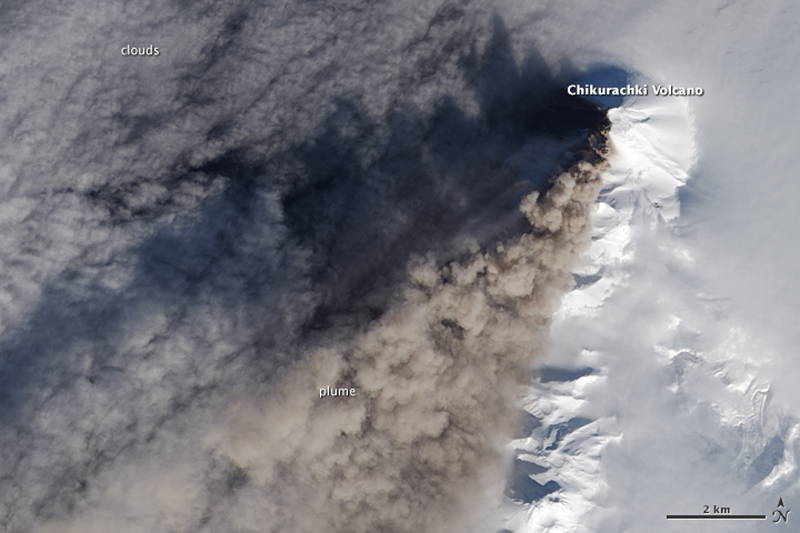Report on Chikurachki (Russia) — June 2016
Bulletin of the Global Volcanism Network, vol. 41, no. 6 (June 2016)
Managing Editor: Edward Venzke.
Research and preparation by Paul Berger.
Chikurachki (Russia) Ash explosions during 15-18 February 2015
Please cite this report as:
Global Volcanism Program, 2016. Report on Chikurachki (Russia) (Venzke, E., ed.). Bulletin of the Global Volcanism Network, 41:6. Smithsonian Institution. https://doi.org/10.5479/si.GVP.BGVN201606-290360
Chikurachki
Russia
50.324°N, 155.461°E; summit elev. 1781 m
All times are local (unless otherwise noted)
An explosive episode at Chikurachki occurred during 15-18 February 2015, the first eruption since the 29 July-8 August 2008 event (BGVN 33:08). This report discusses this short-term episode and another possible one in April 2015. The Kamchatka Volcanic Eruptions Response Team (KVERT) does not monitor the volcano with seismic instruments, but uses satellite monitoring and receives occasional visual observations. All dates and times are UTC (local time + 12 hours).
According to KVERT, the Tokyo Volcanic Ash Advisory Center (VAAC) stated that an explosion at Chikurachki began at 2200 UTC on 15 February 2015 and continued through 18 February (figure 10). The Tokyo VAAC reported that, on 16 February, ash plumes rose to an altitude of 7-7.5 km and eventually drifted up to 230 km W and SW; KVERT also reported a component that drifted E and a thermal anomaly. The Aviation Color Code was raised to Orange on 15 February.
On 18 February, KVERT noted that satellite images showed an ash plume at an altitude of 3.5 km drifting about 280 km E and SE. Satellite images showed no activity on 19 February or immediately thereafter. The Aviation Color Code was lowered to Yellow on 21 February and to Green on 26 February.
An observer from Severo-Kurilsk (60 km NW, Paramushir Island) reported that on 18 April 2015 a gas-and-steam plume from Chikurachki contained a small amount of ash, so the Aviation Color Code was raised to Yellow. However, later analysis of satellite images did not indicate either a thermal anomaly or ash plumes that day. The Aviation Color Code was therefore lowered back to Green on 23 April.
Geological Summary. Chikurachki, the highest volcano on Paramushir Island in the northern Kuriles, is a relatively small cone constructed on a high Pleistocene edifice. Oxidized basaltic-to-andesitic scoria deposits covering the upper part of the young cone give it a distinctive red color. Frequent basaltic Plinian eruptions have occurred during the Holocene. Lava flows have reached the sea and formed capes on the NW coast; several young lava flows are also present on the E flank beneath a scoria deposit. The Tatarinov group of six volcanic centers is located immediately to the south, and the Lomonosov cinder cone group, the source of an early Holocene lava flow that reached the saddle between it and Fuss Peak to the west, lies at the southern end of the N-S-trending Chikurachki-Tatarinov complex. In contrast to the frequently active Chikurachki, the Tatarinov centers are extensively modified by erosion and have a more complex structure. Tephrochronology gives evidence of an eruption around 1690 CE from Tatarinov, although its southern cone contains a sulfur-encrusted crater with fumaroles that were active along the margin of a crater lake until 1959.
Information Contacts: Kamchatka Volcanic Eruptions Response Team (KVERT), Far East Division, Russian Academy of Sciences, 9 Piip Blvd., Petropavlovsk-Kamchatsky, 683006, Russia (URL: http://www.kscnet.ru/ivs/); Tokyo Volcanic Ash Advisory Center (VAAC), Tokyo, Japan (URL: http://ds.data.jma.go.jp/svd/vaac/data/); NASA Earth Observatory, EOS Project Science Office, NASA Goddard Space Flight Center, Goddard, Maryland, USA (URL: http://earthobservatory.nasa.gov/).


